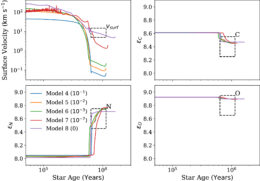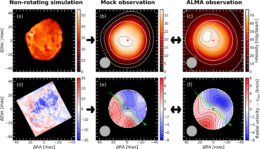
An artist’s impression of a cloud of dust partially blocking Betelgeuse from view during the Great Dimming. [ESO, ESA/Hubble, M. Kornmesser; CC BY 4.0]
Today, we’re introducing three recent articles that examine Betelgeuse’s intriguing behavior and uncertain past.
How Did the Great Dimming Affect Betelgeuse?

Betelgeuse’s brightness (top) and radial velocity (bottom) over time. The Great Dimming, marked by the vertical purple line, appears to have brought about a new periodicity in these quantities. Click to enlarge. [MacLeod et al. 2023]
MacLeod’s team used hydrodynamics simulations to connect the change in variability to changes in the star’s interior. The gaseous outer envelope of Betelgeuse’s atmosphere is constantly churning with large-scale convective motions, similar to the movement of boiling water, that transport heat throughout the star. MacLeod’s team modeled an unusually hot plume of gas that broke free from the star’s surface, powering the surface mass ejection that caused the dimming. When this hot gas plume rose, it could have interrupted Betelgeuse’s typical pulsations, energizing a new pulsation mode that cycles twice as quickly.
If this process is responsible for the change in Betelgeuse’s behavior, the new pulsation mode will eventually lose energy and fade away: MacLeod and collaborators predict that the star should return to its previous 400-day pulsation period within 5–10 years.
Was Betelgeuse Once Two Stars?
Most massive stars grow up with a nearby binary companion, and at some point in their lives these stars may transfer mass back and forth. A recent research article takes this concept of mass transfer to the extreme, exploring whether Betelgeuse engulfed its binary companion, fundamentally altering the course of its evolution.

Results of stellar evolution simulations showing how the surface velocity and nitrogen, oxygen, and carbon abundances change with time. The black boxes indicate the values of these quantities when the modeled stars have similar temperatures and luminosities to present-day Betelgeuse. Click to enlarge. [Shiber et al. 2024]
After allowing the merger product to evolve until its temperature and luminosity were similar to Betelgeuse’s, Shiber’s team calculated the surface composition and rotation rate of the resulting star, since these quantities are potentially measurable. Post-merger stars appear to have more nitrogen at their surface than stars that have evolved normally, and they may rotate more rapidly than typical stars, as well. Observations suggest that Betelgeuse is both rapidly rotating and rich in nitrogen, supporting the hypothesis that it was once two stars.
Is Betelgeuse Actually Rotating Rapidly?
If Betelgeuse is a mashup of two stars, simulations suggest that it should be rotating rapidly. Several years ago, researchers studied Betelgeuse with the Atacama Large Millimeter/submillimeter Array (ALMA) and interpreted the observations to mean that the star was rotating at a rate of 5 kilometers per second — twice the pace expected for a single star. A team led by Jing-Ze Ma (马竟泽) from the Max Planck Institute for Astrophysics investigated this critical piece of evidence by testing whether large-scale convection — the roiling motion that causes material to rise and sink within a star, helping to transport heat from the star’s interior to its surface — could be mistaken for rapid stellar rotation.

The intensity (top row) and radial velocity (bottom row) for a simulated star, simulated ALMA observations, and actual ALMA observations. Click to enlarge. [Ma et al. 2024]
As always, researchers need more data to investigate this issue further. One or more ALMA observations could clarify whether Betelgeuse is truly rotating rapidly, supporting the hypothesis that it’s the result of a stellar merger, or if the star’s massive convective motions have been misleading.
Citation
“Left Ringing: Betelgeuse Illuminates the Connection Between Convective Outbursts, Mode Switching, and Mass Ejection in Red Supergiants,” Morgan MacLeod et al 2023 ApJ 956 27. doi:10.3847/1538-4357/aced4b
“Betelgeuse as a Merger of a Massive Star with a Companion,” Sagiv Shiber et al 2024 ApJ 962 168. doi:10.3847/1538-4357/ad0e0a
“Is Betelgeuse Really Rotating? Synthetic ALMA Observations of Large-Scale Convection in 3D Simulations of Red Supergiants,” Jing-Ze Ma et al 2024 ApJL 962 L36. doi:10.3847/2041-8213/ad24fd
